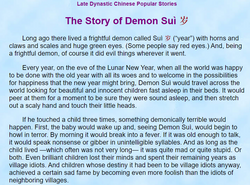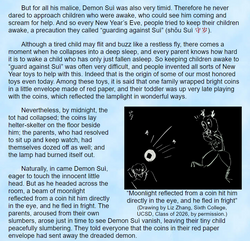Jan 23, 2023
Chinese New Year stories
1
1. The Legend of Why New Year Is Celebrated
Long, long ago in ancient China, there was a fierce beast called “Nian”. Its head looked like a lion with a sharp horn on it which could be used to attack its prey. It lived at the bottom of the sea most of the time and would go ashore only on the last day of the lunar year to eat people and livestock. So on that day every year, people ate early, locked the livestock gate tightly and then fled into the distant mountains to avoid being eaten.
Then one year, an old man with silver hair came to one of the villagers and promised to drive away the cruel beast. However, all of the villagers were too scared to believe him and still fled before nightfall.
2
Nian broke into the village as usual and just as it was ready to butcher its prey and devour it, suddenly the sound of firecrackers arose together with bright flares. Nian trembled and dared not step forward. Then the old man stepped forward dressed in red, and this sent the beast into a frenzy. It was terrified and rushed away.
The second day, after the villagers returned and found their houses and livestock safe and sound they realized that the old man was a celestial being who had come to help them. He also told them the three secret “weapons” to drive Nian away – “items that are red in colour”, “bright lights” and “firecrackers”.
3
From then on, on the last day of the year, people put up red couplets, hung up red lanterns, set off firecrackers, kept the lights on and stayed up late to keep safe from Nian. As time passed, this custom spread to almost every corner of China and thus developed into one of the most important festivals of Chinese people, the Lunar New Year`s Eve.
4
2. The Legend of the Demon Sui



8
3. The Legend Of Why Spring Couplets And Door Gods Are Pasted
It is said that the custom of pasting spring couplets can be traced back to Later Shu over 1000 years ago. According to historical writings, the original form of spring couplets was 'Tao Fu', a kind of peach wood charms hung on the gate during lunar New Year.
9
An ancient Chinese mythology goes that, there was a mountain in the ghostdom and a peach tree covered a circumference of 3,000 miles on the mountain; on the treetop was a Golden Rooster. Every morning when the Golden Rooster announced the break of day, the ghosts wandered at night should come back to the ghostdom. The gate of the ghostdom was located in the northeast of the peach tree and it was guarded by two gods, namely Shen Tu and Yu Lei. If a ghost did something evil at night, it would be caught and tied up by Shen Tu and Yu Lei with a reed rope as the food for tigers. As a result, all the ghosts dreaded Shen Tu and Yu Lei; people in the folk carved the images of the two on the peach wood and hung the charms on the gate to ward off evil spirits. This kind of peach wood charms was called 'Tao Fu'. With the development of times, 'Tao Fu' also changed: people wrote the name of Shen Tu and Yu Lei on 'Tao Fu' to replace the images and later wrote the short poems, in symmetrical structure and with one-to-one correspondence, on 'Tao Fu'. This was the precursor of spring couplets. Nowadays, the spring couplets are wrote on red paper which has auspicious meanings.
10
To pray for good fortune, long life, health and peace, people in some places would paste Door Gods. Since Tang Dynasty, people also take Qin Shubao and Yuchi Gong, two military officers in Tang Dynasty, as the Door Gods in addition to Shen Tu and Yu Lei. It is said that, all evil spirits, ghosts and monsters would be scared away once the gate is pasted with two Door Gods. According to a legend, Emperor Taizong of Tang was sick and heard the cry of ghosts outside, thus felt restless for all the night. Therefore, he ordered the two military officers Qin Shubao and Yuchi Gong to hold their weapons and guard his gate. In the next day, he was no longer troubled by the ghosts. Later, Emperor Taizong asked people to paint the portraits of the two generals and paste on the gate. Hence, the custom was widely circulated in folk. Since the gate of Chinese folk house is in folios, the Door Gods are usually in pairs.
By undefined
10 notes ・ 68 views
English
Elementary